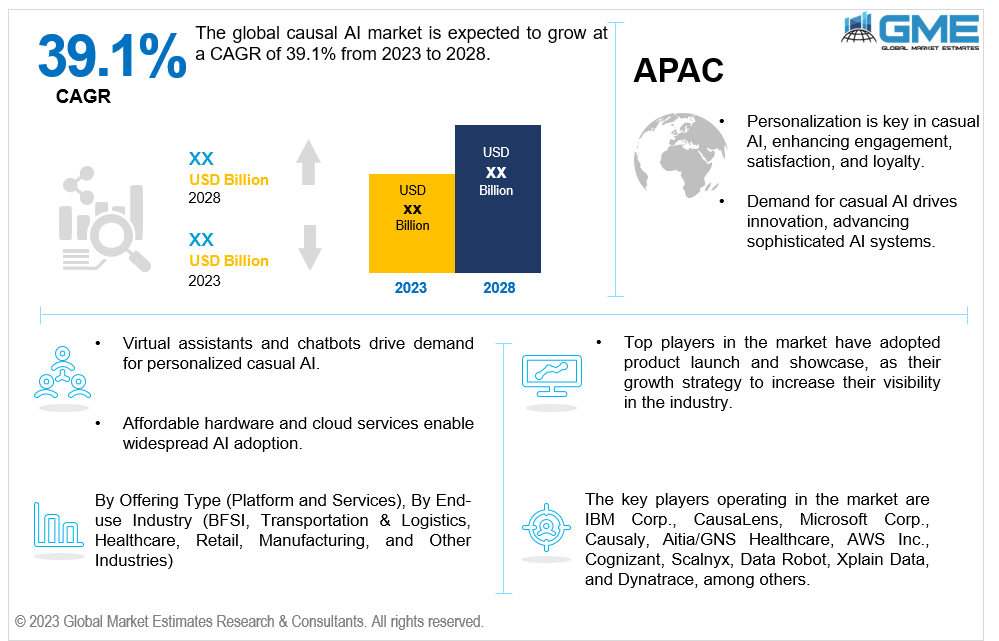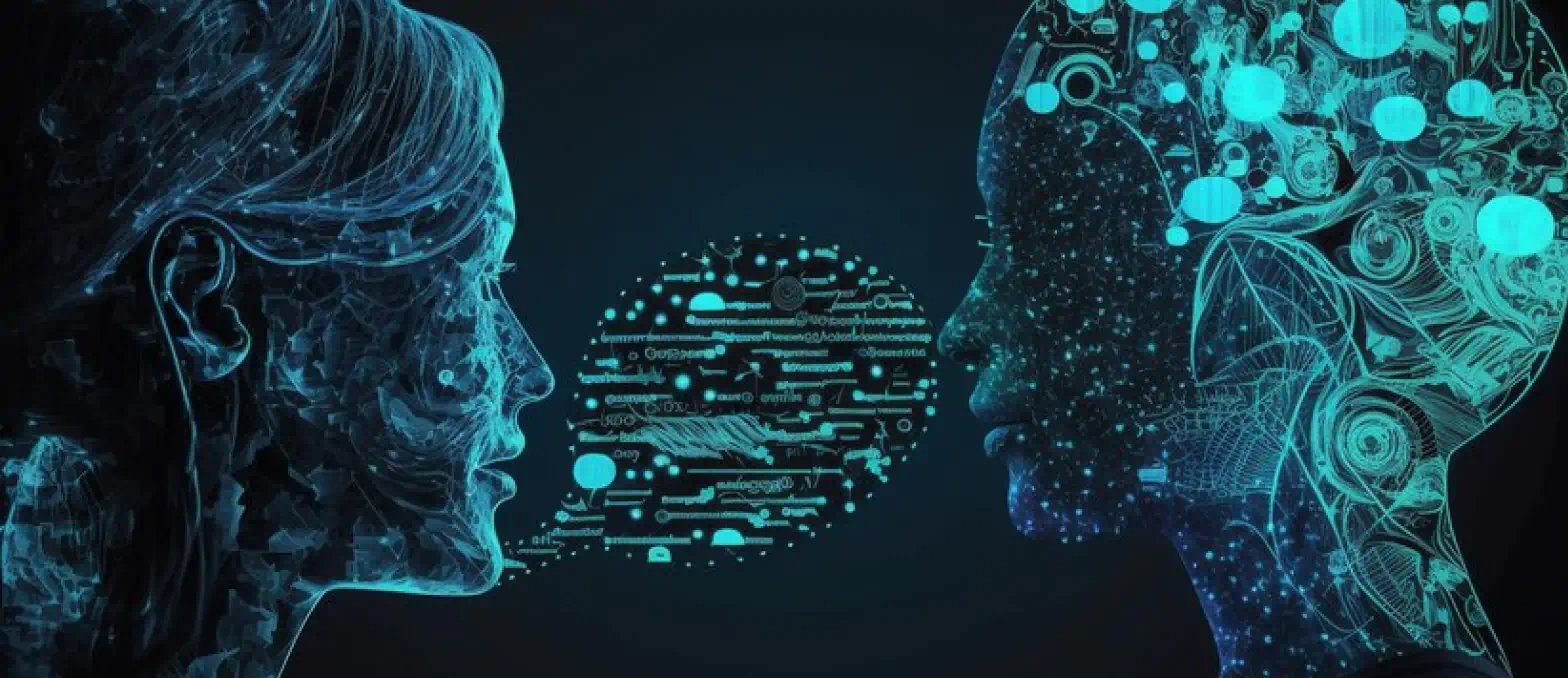Table of Contents
Causal AI: An Overview
Artificial intelligence is transforming lives in profound ways. While generative AI steals most of the headlines, there’s a revolution taking place, known as Causal AI. When fully developed, it will take AI into an entirely different league, and it is one of the most compelling areas in the very fast-changing field. Causal AI promises more precise decision-making and deeper insights than ever before. But what exactly is Causal AI, and why should we pay attention to it?
Causal AI surpasses traditional analytics by deeply exploring the cause-and-effect relationship rather than pure pattern identification or correlations. Traditional AI models, like machine learning, are great at identifying correlations or pairs of events that tend to happen together. But they answer less fundamental questions, for example, “Why did this happen?” or “What if we did this instead?” This is where causal AI comes in and gives you a more resilient decision-making framework to understand how one thing actually affects the other. We apply Causal AI along various verticals such as finance, healthcare, retail, and marketing. A new opportunity for businesses that can help to strategize and thereby improve ROI substantially has the power of more accurate prediction outcomes with actionable insights.
With the evolution of technology, causal AI is gaining momentum as a powerful tool that can transform how we approach problem-solving. In this blog, we’ll explore causal AI’s current state, explore use cases of Causal AI, and examine its exciting potential for the future of technology and business.
Key Statistics of Causal AI
Causal AI is rapidly gaining traction across a range of industries because it can help harness cause-and-effect relationships rather than only correlations that traditional AI technologies identify. As technology advances, its adoption is likely to increase rapidly, changing how businesses make decisions.
- The worldwide causal AI market is expected to grow significantly, from $26 million in 2023 to $293 million by 2030, driven by advancements in AI technology and increasing adoption across multiple industries.
- A report by Global Market estimates the causal AI market will greatly grow at a CAGR of 39.1% from 2023 to 2028, with the APAC region experiencing strong growth due to the rise of virtual assistants and strategic initiatives from major companies like IBM and Microsoft.
- According to Gartner, causal AI technology currently has a market penetration of only 1% to 5% of its target audience, highlighting the considerable potential for future growth and adoption.
Read More – Artificial Intelligence Statistics

Use Cases and Applications of Causal AI across Industries
The evolution of causal artificial intelligence has revolutionized sectors and let businesses and large organizations move beyond basic correlations defining outcomes. In many different sectors, causal artificial intelligence has shown its adaptability and effectiveness; its abilities extend beyond theory. In this section, we will explore the key use cases of Causal AI. Let’s have a look:
Healthcare and Medical Research
In healthcare, causal AI is vital for enhancing patient care and treatments. Causal AI helps determine the most significant factors impacting health outcomes, by processing large amounts of data, including patient health histories, lab tests and other responses, treatment variables and outcomes. By doing so, it enables practitioners of healthcare to tailor and personalize the treatment for specific patients enabling them to get completely healed.
Pharmaceutical companies are not the only ones using causal AI to gain an understanding of the molecular pathways leading to disease that aid in new therapies design. Causal AI that pinpoints causal connections between disease progression and treatment advantage greatly improves the clinical trial method, medications development, and the introduction of novel therapies.
Financial Services and Risk Management
Causal AI is used by financial institutions to enable you to make better decisions and do business with reduced risk. Risk assessment is traditionally based on historical trends, but causal AI suggests the triggers of risks (e.g. factors that arise in markets or human behaviour). Since all asset prices result from numerous factors ranging from market regime shifts to geo-political events to other corporate actions, the use of causal AI assists investment firms to fully capture the adjusted portfolio performance of asset price changes. In the fraud detection domain, causal AI uncovers anomalies as well as the origins of fraud to enable quicker action and minimize losses.
Marketing and Customer Insights
Causal AI could be the game changer for marketing professionals who want to maximize strategies and increase returns. It unearths the factors that drive consumers to action; companies can use it to identify what characteristics (such as messages, marketing channels, or timing) affect sales and engagement. This information can be used to provide more accurate and precise estimates of conversions and sales, which ensures that marketing budgets are efficiently allocated.
Supply Chain Optimization
AI causality helps companies enhance supply chain management by discovering the main causes of delays and inefficiencies. When it analyzes data from several sources, such as logistics providers, suppliers, and production lines, causal AI can determine how the delay in a particular part of the supply chain can impact downstream operations. It allows companies to adjust their processes based on data to improve the efficiency of the supply chain overall. It could be reducing the cost of inventory and reducing waste or increasing delivery times. Causal AI can provide the data needed to optimize processes and build a more flexible and productive supply chain.
Policy-making and Governance
Causal AI is gaining traction in public sector and government institutions to facilitate informed policymaking and improve governance quality. Causal AI helps policymakers understand which changes are likely to affect which sectors and industries, for which types of behavioral change, by simulating the likely consequences of new policies or interventions.
It provides information on the causal and effect relationships that underpin the root cause of social problems making possible better-informed decisions in the formulation of the most effective educational programs, public health changes, or economic projects. Likewise, Causal artificial intelligence can not only critique the effect of previous policies, but then also assist governments with using those critiques to refine strategies and optimize resource allocations for reaching those targets.
Causal AI for Fraud Detection
Causal AI plays a crucial role in improving the effectiveness of fraud detection across all sectors. Conventional methods of detecting fraud depend on patterns to identify suspicious activity. However, causal AI is more thorough in studying the causes that lead to fraud. By identifying unusual behavior or incidents, causal AI can identify potential triggers for fraud and inform security staff of any damage that may occur.
This proactive strategy improves the efficiency of fraud detection by decreasing false positives and swiftly addressing legitimate threats. In addition, causal AI assists businesses in identifying weaknesses within their security systems and improving overall cybersecurity.
Credit Risk Analysis
Banks and financial institutions are continuously pressured to evaluate the risk of lending money to businesses or private individuals. Causal LLM improves the process of assessing credit risk by studying prior financial habits and identifying the root variables that impact the borrower’s capacity to repay loans. For instance, causal AI may find that a borrower’s debt-to-income ratio is less predictive of repayment. Using these insights, institutions can make informed lending decisions, lower defaults, and better serve their customers.
Customer Churn Analysis
It is very important for businesses to understand why customers leave. However, causal AI enables companies to do more than simple correlation analysis; it helps to identify the very actions or events that can be correlated with customers leaving. It could, for instance, find that delivery delays or poor customer service can be the major cause of the churn rate, which allows companies to focus on these areas for improvements. Based on this information, companies can implement individualized retention strategies, including discounts and enhancing their products’ quality to improve customer satisfaction and lower churn percentages.
Campaign Performance Measurement
AI causality assists marketers in moving beyond performance metrics to comprehend the real effects of their campaigns. Causal AI provides a deeper insight into what drives the success of campaign by identifying the causal relationships of elements of the campaign e.g. time, content, audience, with the results e.g. engagement or sales. It allows companies to improve their marketing strategies and concentrate on elements with the greatest causal effect. This leads to more efficient campaigns, better budget allocation, and maximum ROI.
Predictive Maintenance in Manufacturing
Causal AI is transforming the manufacturing industry by identifying the root causes of equipment failure before they happen. Causal AI makes it easy to identify early indicators of wear and tear through constant monitoring of machinery and suggest steps to take to prevent expensive failures. Such a proactive method aids in minimizing downtime while prolonging the equipment life and maximizing production schedules. Causal AI takes the guesswork out of maintenance decisions and assures that equipment operates as needed by providing a refined understanding of the factors contributing to performance and condition
Crime Prevention and Law Enforcement
Crime prevention and law enforcement are other domains where causal AI is invaluable. Based on the insights from past crimes and the underlying motivations for criminal behavior, law enforcement agencies can formulate more effective strategies for crime prevention. For example, causal AI can help discover a link between crime rates in certain areas and socio-economic factors, such as unemployment or lack of education, which social system experts can use to devise policy and intervention strategies.
Environmental Impact Analysis
There are factories and companies that are observing their footprint on nature with the help of causal AI and trying to minimize their effect. Causal artificial intelligence enables organizations to gain insights into the general environmental impacts of their activities by investigating the causal relationships between people’s actions (e.g., emissions, deforestation) and environmental outcomes (e.g., climate change, biodiversity loss). It allows businesses to implement more sustainable processes, reduce their environmental impact, and meet environmental standards
Customer Lifetime Value Prediction
A relatively new application of causal AI is to estimate customer lifetime value (CLV), one of the key drivers of long-term revenue for firms. Causal LLM uses the purchase history, interactions, and engagement with the customer, over time to figure out which variables impact the lifetime value of the customer the most. With causal AI, businesses can better examine their marketing, sales, and retention efforts to focus on the highest-value customers. Besides optimizing better customer acquisition strategy, knowledge of the causal drivers of CLV will help the company personalize offers to keep the customer engaged.
Retail Demand Forecasting
Demand forecasting is necessary for retailers to manage stock and keep the supply chain in control. Causal AI looks at the complex relationships among variables like seasonality, promotions, economic conditions, consumer behavior and more to assess the impact of these drivers on future demand more accurately. Stock allocation helps those businesses to maintain the right products, at the right quantity, and at the right time, eliminating the chance of stock out or overstocking risk. It improves consumer experience and loyalty and lowers store waste, strengthening their profitable company model.
Benefits of Causal AI for Businesses
Causal AI changed the way businesses accurately decide where to invest based on available data. That enables businesses to achieve an advanced optimal model, higher productivity, and better predictability. After discussing the use cases of Causal AI, we will now move forward to the benefits of Causal AI to improve business processes.
Improved Decision-Making Precision
Causal AI helps improve decision-making by revealing real cause-and-effect relationships rather than mere connections. That clarity enables firms to make more reliable, data-driven decisions and ensure that those decisions are grounded in real causal drivers, not spurious correlations.
Enhanced Predictive Accuracy
Traditional AI models are often unable to cope with changes in the environment. Causal AI is more versatile as it knows how different variables affect the results. Even in changing market conditions, it can predict accurately, which creates a sustainable business strategy in the varying market settings
Mitigation of Bias and Promotion of Fairness
Causal AI can identify and correct biases in decision-making systems by modeling the relationships between sensitive attributes and results. This functionality guarantees AI-powered decisions are more transparent, fairer, and ethical across use cases in varied industries.
Efficient Use of Data
One of the main benefits of Causal AI is the capacity to work well with smaller datasets. Because AI causality emphasizes determining causal relationships in the data, it can derive actionable insights with far smaller datasets. Therefore, it is much more cost-effective and resource-efficient.
Difference Between Causal AI and Traditional Machine Learning
Two fundamental technologies in the field of artificial intelligence are causal AI and machine learning. However, their approach to problem-solving differs. While causal artificial intelligence seeks to offer insight into the elements behind those patterns, machine learning often shines in recognizing patterns and predictions based on past data. Now that we have established a foundation of information related to causality and machine learning, let us go over the fundamental differences between causal AI vs traditional machine learning in this section.
| Aspect | Traditional Machine Learning | Causal AI |
| Approach to Data | Uses large datasets to find patterns and make predictions based on correlations, without understanding the causes. | Focuses on discovering the causes behind outcomes, explaining how one factor affects another. |
| Interpretability | Often treated as a “black box” where it’s difficult to understand how decisions are made. | Offers clearer insights into decision-making by showing how changes in one factor cause changes in another. |
| Predictive Power | Good at predicting future events using past data, but lacks insight into why things happen. | Provides deeper insights into the reasons behind predictions, leading to better decision-making. |
| Applications | Commonly used in image recognition, speech processing, and recommendation systems, focusing on pattern recognition. | Best for fields like healthcare, economics, and social sciences, where understanding causes and effects is crucial. |
Challenges of Implementing Causal AI
Through the identification of the causes and effects of relationships in data, causal artificial intelligence can significantly change business strategies. Adopting Causal artificial intelligence presents many difficulties for companies that have to be resolved for successful deployment. Here are the main challenges and ways organizations should overcome them to realize the full potential of causal AI.
Data quality
Causal AI models require quality data integrity to run effectively. Poor or partial information might lead to incorrect conclusions. Since these issues seem quite inconvenient, we could use data imputations for the missing values and extensive validation to identify some discrepancies or biases in the data-sets.
Complexity
AI causality includes analyzing complicated interactions between multiple variables that can make it challenging to pinpoint the root causes behind the results. In order to overcome this, you require advanced algorithms that can analyze interdependencies for it, and more importantly, capable of adequately reading the dependencies.
Collaboration with Domain Experts
AI algorithms can identify patterns and correlations from the data, but the interpretation of such findings remains reliant on human expertise to relate those findings to the context. Causal LLM models need to be validated by domain experts to confirm that they are consistent with the reality and, as a result, a data scientist has to be teamed with domain specialists. It helps provide context and make AI-driven insights sharper which in turn can aid in decision-making.
The Future of Causal AI
Causal AI is a game changer in discovering the complex causal and effect relationships within data. It can provide useful insights for companies. Causal artificial intelligence will continue to be challenged still as technology changes and data becomes more complex. Yet, some exciting advances are in the near future that can enhance the capabilities of causal AI. Let’s have a look at some of them:
Refined Causal Inference Methods
If techniques improve in causal inference, causal relationships can be identified more accurately. Time will allow the algorithms to improve themselves at mounting complexities and relationships throughout the variables, and deciphering correlation and causation to accurately draw actionable conclusions.
Improved Predictive Accuracy
The predictive capability of causal AI models should improve as Causal AI models continue to develop. Stronger algorithms and varied data sets will also help future models to more precisely predict the future and let businesses make more informed decisions with deeper awareness of the causal dynamics.
Seamless integration with Emerging Technologies
Modern technologies including machine learning (ML) and automation are predicted to be progressively coupled with causal artificial intelligence. Technologies working together will allow businesses to use causal AI to simplify decision-making procedures and simultaneously increase insight. This will help operations to be more effective and allow real-time changes depending on found causative elements.
How A3Logics Can Implement Causal AI in Your Organization?
A3Logics is a reputable enterprise AI development company dedicated to providing custom AI solutions to solve unique business problems and create solutions for growth. By integrating causal artificial intelligence into operational processes, we help businesses to examine complex cause-and- effect connections and therefore improve knowledge of their systems and processes. Our causal AI assesses and visualizes interrelationships between your company application, network, and service.
Equipped with the best-in-class causal AI models, based on counterfactual thinking, our solutions empower the companies to perform the ‘what-if’ analysis for improved planning and strategy formulation. They allow businesses to iterate on their operating plans and forecast potential outcomes. A3Logics causal AI models are able to adapt and learn from the real-time data to ensure they remain effective and accurate. These adaptable systems allow your company to stay ahead of the trends specific to your industry and adapt to emerging problems, making your business more agile and competitive differentiators.
Through our causal AI model and AI consulting services we provide companies the chance to streamline processes, improve decision-making, and inspire creativity so they may be future-ready in an always competitive environment.
Conclusion
Causal AI is a significant technological breakthrough in artificial intelligence, allowing businesses to transcend basic assumptions and understand the variables that influence the outcome. This is the technology that enables businesses to make better decisions, optimize their operations, minimize risk, and, most importantly, adjust to the dynamic nature of the world we live in today.
Unlike all existing AI models, which mainly searches for correlation, Causal artificial intelligence goes beyond correlation and tries to dig out the causal relationships of cause-and-effect type; a driver of outcomes. More and more advanced predictive analytics will allow for even better decision making or the ability for an organization to predict the future and change it with increased accuracy.
Mastering AI causality is a long bumpy road. It relies on access to higher quality data, knowledge of domain-specific knowledge, and close coupling of technical experts with real world practitioners. Despite these obstacles, the benefits of causal AI are significant, offering greater autonomy in decision-making, improved operational efficiency, and more adaptable systems that can better navigate complex environments.
As causal AI advances, companies adopting the technology and AI development services will discover new insights and innovations. Beyond simple projections, knowledge of the real causes of success could help companies to change their strategies, lower risk, and generate better outcomes.





